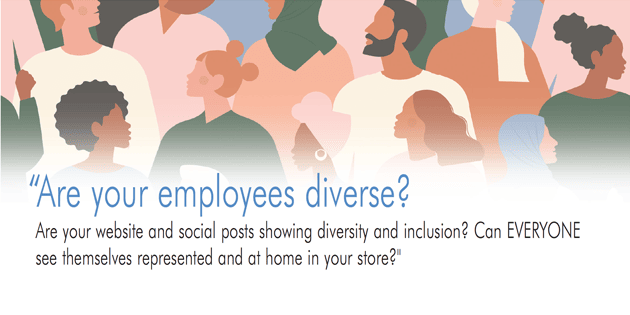
Can every person who works, shops or engages with
your store's messaging see themselves represented, respected and comfortable?
As children, we all learned the Golden Rule: “Do unto others as you’d have them do unto you.” In retail, that adage continues to be more relevant than ever. As our communities become increasingly diverse, it’s critical for our industry to evolve and adapt to create an inclusive, welcoming shopping experience for all customers. Most consumers prefer to buy and support local, so what are you doing to include EVERYONE?
Respect: It all starts with respect. It may sound simplistic, but treating people with the same level of respect you expect from others is the first step to creating an inclusive shopping experience. That respect permeates every aspect of your business and customer service—everything from treating each customer equally no matter who they are to making sure your store is welcoming and accessible for all. Is your store ADA accessible? If not, you’re unintentionally telling physically challenged shoppers they’re not welcome, missing out on potential sales and alienating members of your community.
Inclusive To All: This leads to my next point—make sure your business is inclusive to all, not just people who look and think like you. Does your advertising represent a wide swath of the population? Do you hire people based on how you look or how your entire trading area looks? Creating a brand that people can see themselves in—from advertising to employees—will make it more likely they see themselves enjoying the products you sell, too.
Social Media: Another key component to building an inclusive brand is your social media. When posting images, be cognizant of diversity—even if you’re simply using stock photos, try to make sure the people depicted on your social accounts represent people of a variety of ethnic backgrounds. And you likely post holiday greetings for Christmas and Independence Day, but do you also recognize Juneteenth, Rosh Hashanah or Ramadan? Creating posts marking holidays celebrated by other ethnic groups and religions is an easy way to let your community and customers know you care about inclusivity and respect the beliefs of all, even if you don’t personally celebrate those days.
Speaking of holidays, we know that in recent years there have been questions raised about the cultural sensitivity of holidays such as Columbus Day that often coincide with retail sales. If you feel concerned about seeming insensitive but don’t want to miss an opportunity when your competitors are having sales, perhaps change your approach. Rather than Columbus Day, make it a fall sale. You can still offer deals without unintentionally excluding potential customers.
Store Policies: Once you’ve identified changes to make and places to grow, the next step is incorporating these initiatives in your store policies. Putting a commitment to inclusivity and diversity in writing makes it easier to implement these changes and make sure your employees understand the company culture you’re trying to cultivate. And should someone disregard or go against these policies, having a stated set of guidelines available allows you to hold employees accountable if they don’t meet your expectations.
Integrity: Everyone with a home—be it a house, apartment, condo or mobile home—needs furniture, which means everyone is your potential customer. And with consumers spending more time at home, the furniture industry is in a prime position to sell to everyone. Are you making everyone feel welcome? Are your ads inclusive? Are your employees diverse? Are your website and social posts showing diversity and inclusion? Can EVERYONE see themselves represented and at home in your store? Being able to answer these questions in the affirmative can mean the difference between growing your business and falling behind. Evolving with changing times not only demonstrates your business savvy, it also shows you are a person of integrity who understands the Golden Rule is more than just a saying.
